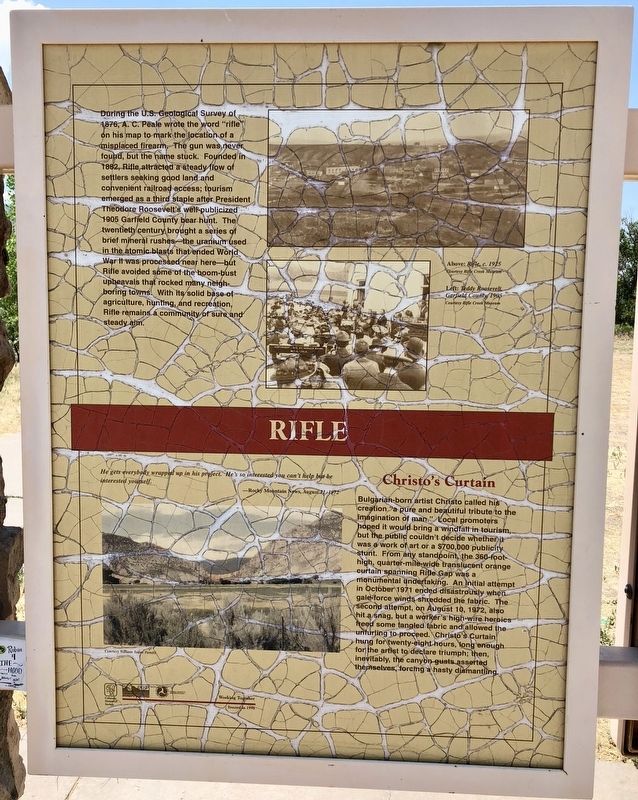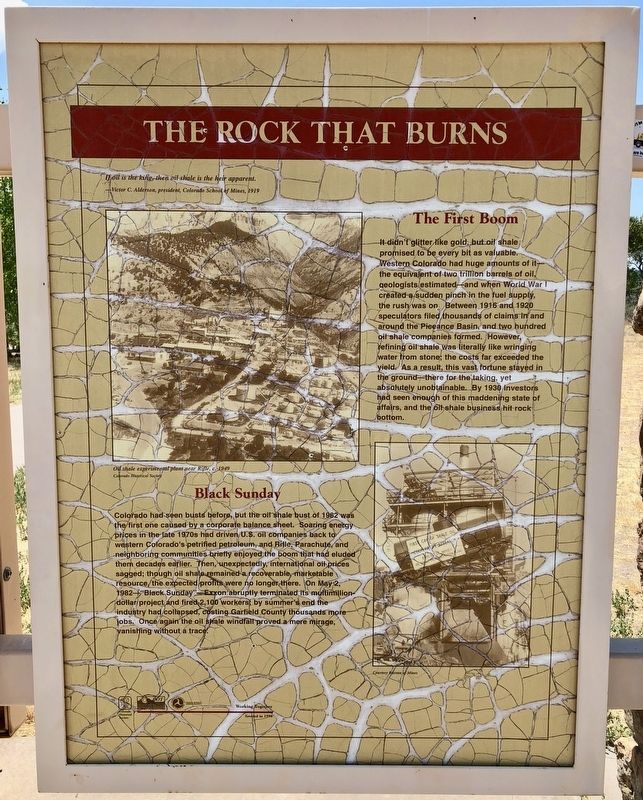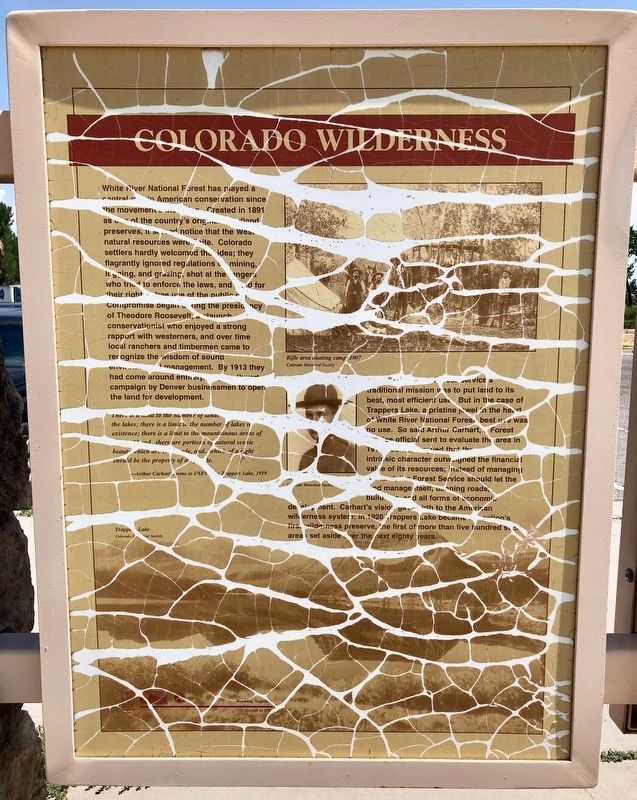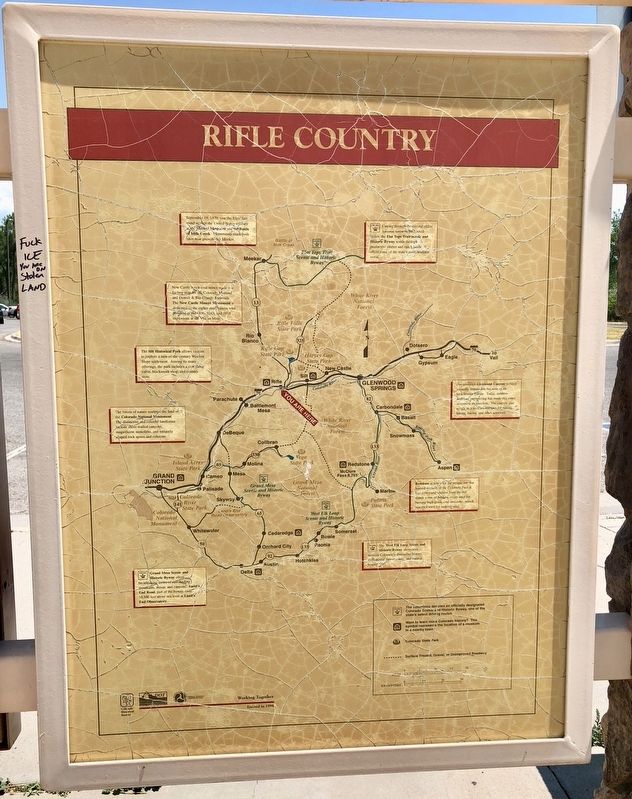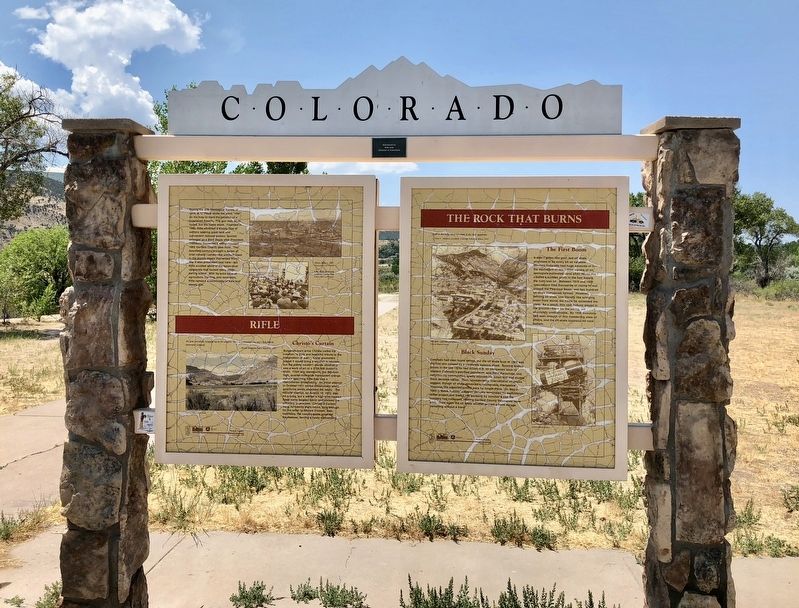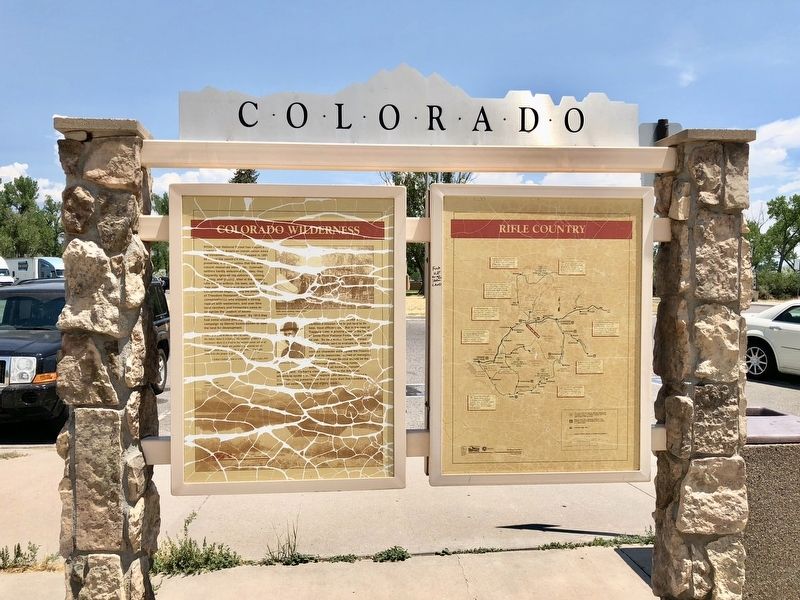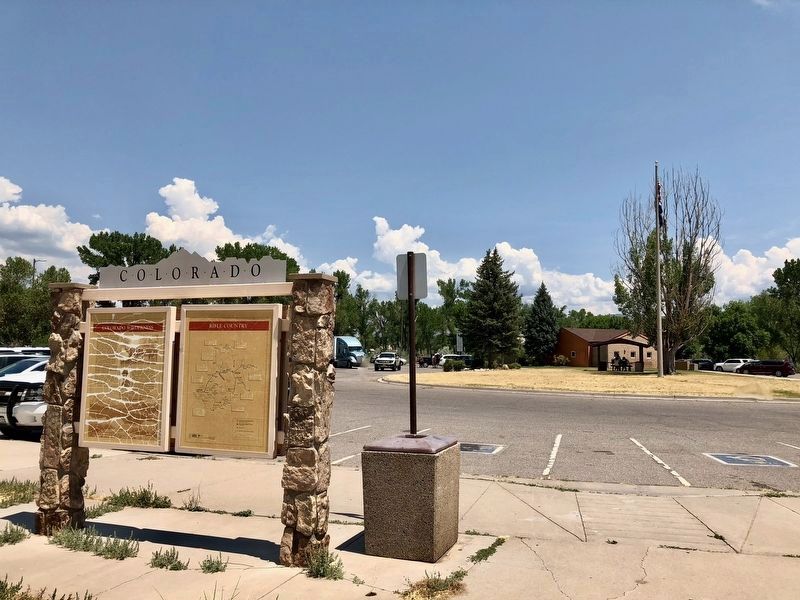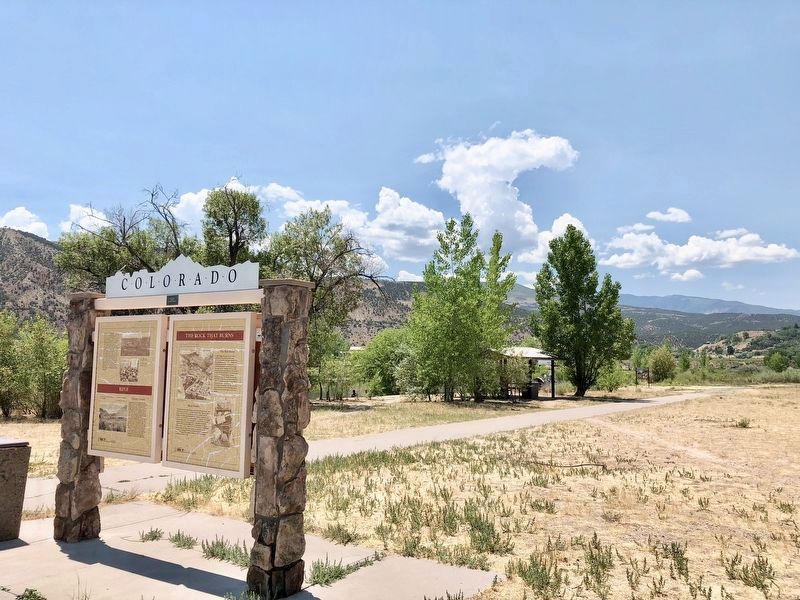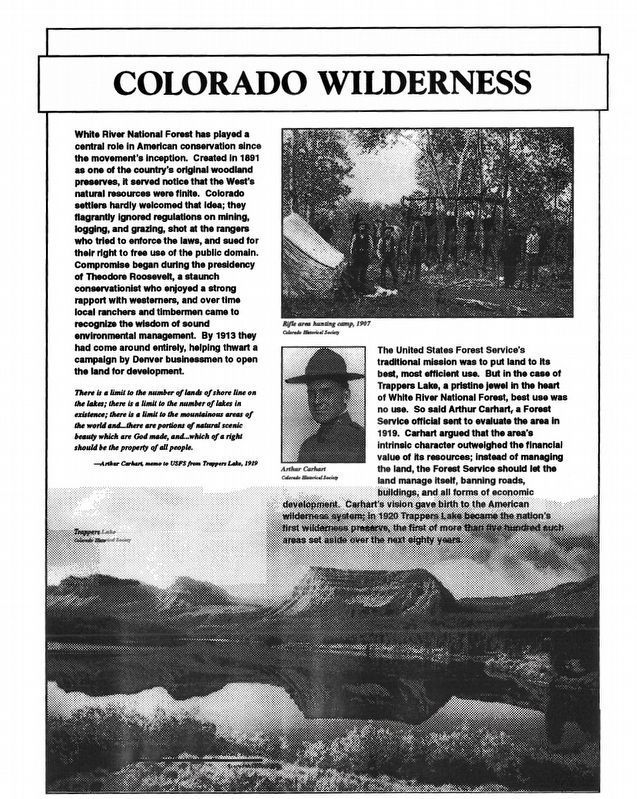Rifle in Garfield County, Colorado — The American Mountains (Southwest)
Rifle / The Rock That Burns / Colorado Wilderness / Rifle Country
During the U.S. Geological Survey of 1876, A.C. Peale wrote the word "rifle" on his map to mark the location of a misplaced firearm. The gun was never found, but the name stuck. Founded in 1882, Rifle attracted a steady flow of settlers seeking good land and convenient railroad access; tourism emerged as a third staple after President Theodore Roosevelt's well-publicized 1905 Garfield County bear hunt. The twentieth century brought a series of brief mineral rushes—the uranium used in the atomic blasts that ended World War II was processed near here—but Rifle avoided some of the boom-bust upheavals that rocked many neighboring towns. With its solid base of agriculture, hunting, and recreation, Rifle remains a community of sure and steady aim.
Bulgarian-born artist Christo called his creation “a pure and beautiful tribute to the imagination of man." Local promoters hoped it would bring a windfall in tourism, but the public couldn't decide whether it was a work of art or a $700,000 publicity stunt. From any standpoint, the 360-foot-high, quarter-mile-wide translucent orange curtain spanning Rifle Gap was a monumental undertaking. An initial attempt in October 1971 ended disastrously when gale-force winds shredded the fabric. The second attempt, on August 10, 1972, also hit a snag, but a worker's high-wire heroics freed some tangled fabric and allowed the unfurling to proceed. Christo's Curtain hung for twenty-eight hours, long enough for the artist to declare triumph; then inevitably, the canyon gusts asserted themselves, forcing a hasty dismantling.
It didn't glitter like gold, but oil shale promised to be every bit as valuable. Western Colorado had huge amounts of it the equivalent of two trillion barrels of oil, geologists estimated—and when World War I created a sudden pinch in the fuel supply, the rush was on. Between 1916 and 1920 speculators filed thousands of claims in and around the Piceance Basin, and two hundred oil shale companies formed. However, refining oil shale was literally like wringing water from stone; the costs far exceeded the yield. As a result, this vast fortune stayed in the ground —there for the taking, yet absolutely unobtainable. By 1930 investors seen enough of this maddening state of affairs, and the oil shale business hit rock bottom.
Colorado had seen busts before, but the oil shale bust of 1982 was the first one caused by a corporate balance sheet. Soaring energy prices in the late 1970s had driven U.S. oil companies back to western Colorado’s petrified petroleum, and Rifle, Parachute and neighboring communities briefly enjoyed the boom that had eluded them decades earlier. Then, unexpectedly international oil prices sagged; though oil shale remained a recoverable, marketable resource, the expected profits were no longer there. on May 2, 1982—"Black Sunday” —Exxon abruptly terminated its multimillion-dollar project and fired 2,100 workers; by summer's end the industry had collapsed, costing Garfield County thousands more jobs. Once again the oil shale windfall proved a mere mirage, vanishing without a trace.
White River National Forest has played a central role in American conservation since the movement's inception. Created in 1891 as one of the country's original woodland preserves, it served notice that the West's natural resources were finite. Colorado settlers hardly welcomed that idea; they flagrantly ignored regulations on mining, logging, and grazing, shot at the rangers who tried to enforce the laws, and sued for their right to free use of the public domain. Compromise began during the presidency of Theodore Roosevelt, a staunch conservationist who enjoyed a strong rapport with westerners, and over time local ranchers and timbermen came to recognize the wisdom of sound environmental management. By 1913 they had come around entirely, helping thwart a campaign by Denver businessmen to open the land for development.
The United States Forest Service's traditional mission was to put land to its best, most efficient use. But in the case of Trappers Lake, a pristine jewel in the heart of White River National Forest, best use was no use. So said Arthur Carhart, a Forest Service official sent to evaluate the area in 1919. Carhart argued that the area's intrinsic character outweighed the financial value of its resources; instead of managing the land, the Forest Service should let the land manage itself, banning roads, buildings; and all forms of economic development. Carhart's vision gave birth to the American wilderness system. In 1920 Trappers Lake became the nation's first wilderness preserve, the first of more than five hundred such areas set aside over the next eighty years.
{Area map of historical & geographical highlights}
Erected 1998 by the Colorado Historical Society, Colorado Department of Transportation.
Topics and series. This historical marker is listed in these topic lists: Horticulture & Forestry • Natural Resources • Settlements & Settlers. In addition, it is included in the Former U.S. Presidents: #26 Theodore Roosevelt series list. A significant historical date for this entry is May 2, 1876.
Location. 39° 31.47′ N, 107° 47.217′ W. Marker is in Rifle, Colorado, in Garfield County. Marker can be reached from Lion's Park Circle, 0.6 miles west of State Route 13. Located within the CDOT Rifle Rest Area at Interstate 70, exit 90. Touch for map. Marker is at or near this postal address: Lion's Park Circle, Rifle CO 81650, United States of America. Touch for directions.
Also see . . . Wikipedia article on the history of Rifle. (Submitted on July 24, 2018, by Mark Hilton of Montgomery, Alabama.)
Additional commentary.
1. Marker damage
Due to the average 300 days of sunshine in Colorado, this marker has sustained a lot of damage, making parts of it unreadable. History Colorado (Colorado Historical Society) graciously has provided original wording of the worst panel (see photo).
— Submitted July 24, 2018, by Mark Hilton of Montgomery, Alabama.
Credits. This page was last revised on July 25, 2018. It was originally submitted on July 24, 2018, by Mark Hilton of Montgomery, Alabama. This page has been viewed 591 times since then and 65 times this year. Photos: 1, 2, 3, 4, 5, 6. submitted on July 24, 2018, by Mark Hilton of Montgomery, Alabama. 7, 8, 9. submitted on July 25, 2018, by Mark Hilton of Montgomery, Alabama.
